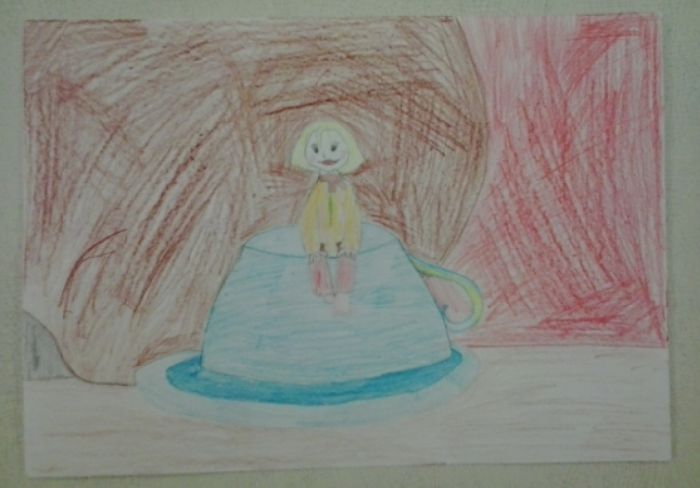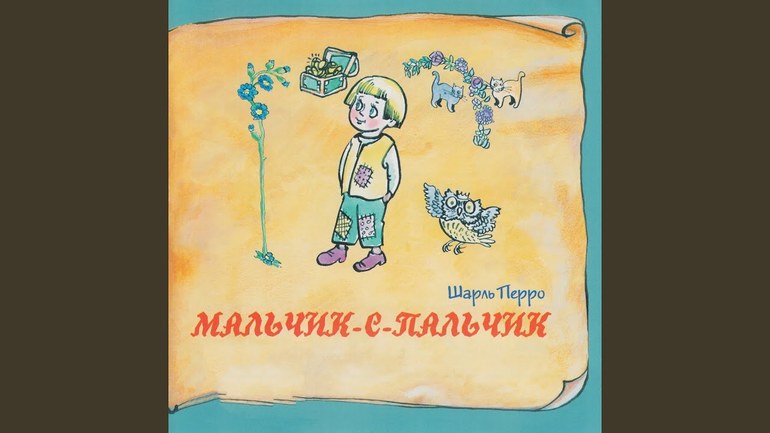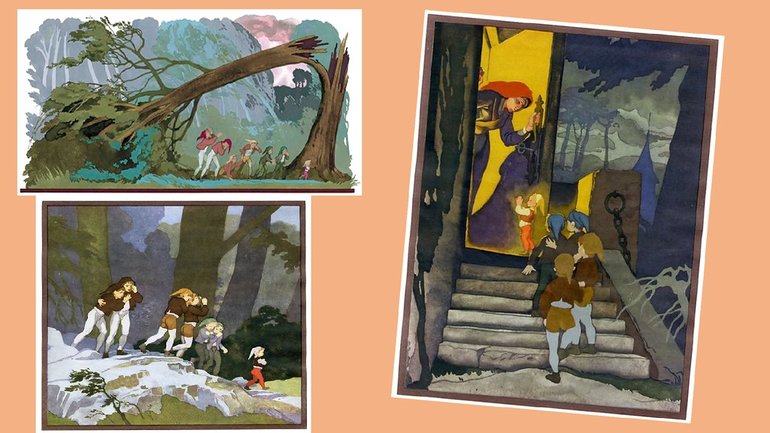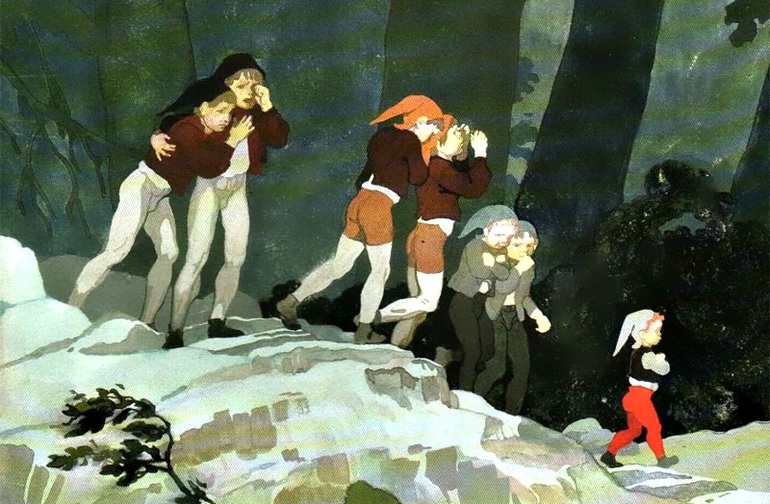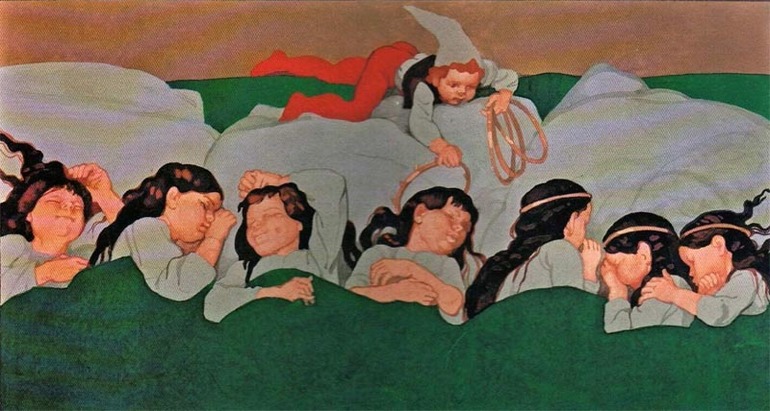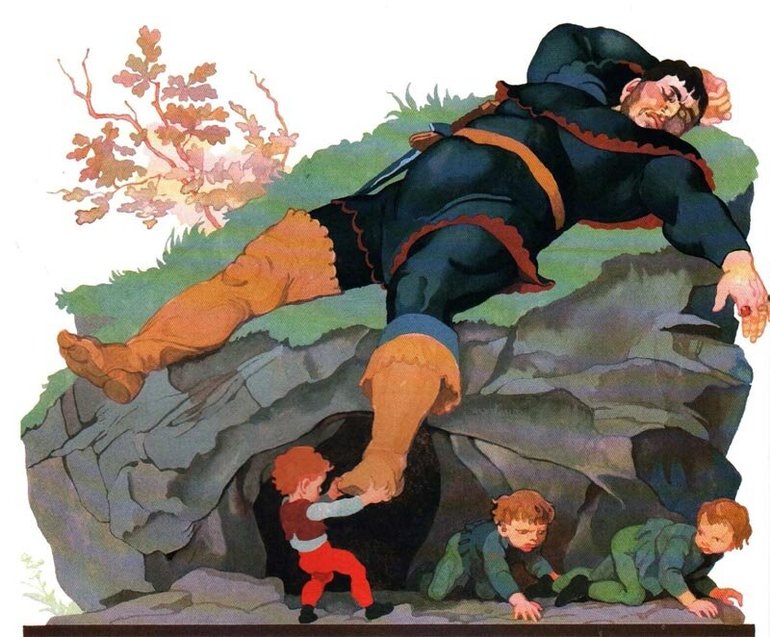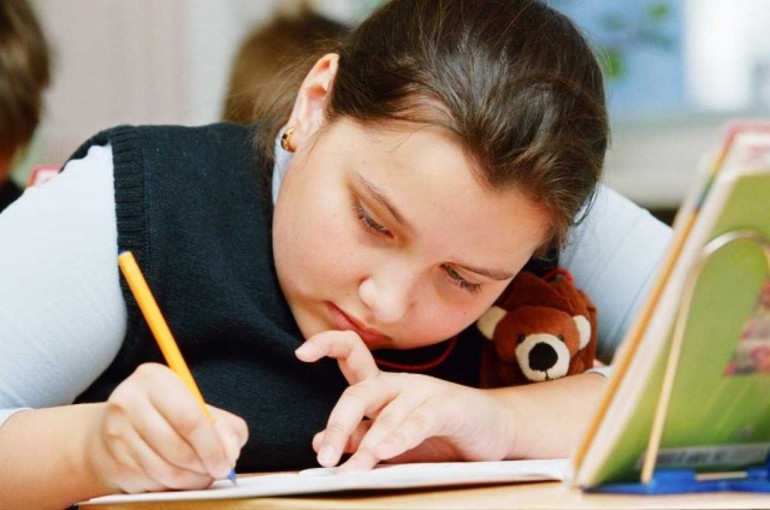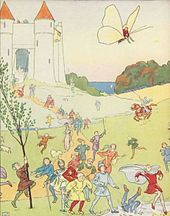«Мальчик-с-пальчик» читательский дневник
«Мальчик-с-пальчик» – поучительная сказка о крошечном мальчике, который оказался гораздо умнее и смелее своих старших братьев, которых он трижды спас от верной смерти.
Краткое содержание «Мальчик-с-пальчик» для читательского дневника
ФИО автора: Шарль Перро
Название: Мальчик-с-пальчик
Число страниц: 5. Шарль Перро. «Сказки». Издательство «Росмэн». 1999 год
Жанр: Сказка
Год написания: 1697 год
Опыт работы учителем русского языка и литературы — 27 лет.
Главные герои
Мальчик-с-пальчик – очень умный, смекалистый маленький мальчик.
Братья Мальчика-с-пальчика – самые обычные мальчишки.
Родители Мальчика-с-пальчика – добрые, любящие, но очень бедные люди.
Людоед – жестокий, страшный, глупый и вечно голодный.
Жена людоеда – добрая, отзывчивая женщина.
Сюжет
Жил-был дровосек с женой, и было у них семеро сыновей. Все сыновья были крепкими и здоровыми, и только самый младший родился таким крошечным, что все его звали Мальчик-с-пальчик.
Однажды наступила сильная засуха, которая длилась так долго, что начался голод. Не в состоянии больше прокормить семью, дровосек решил увести детей в дремучий лес. Он надеялся, что в лесу у них появится шанс выжить, поскольку дома их ждала верная смерть от голода.
О планах родителей узнал Мальчик-с-пальчик и набил свои карманы блестящими маленькими камушками. Когда отец утром отвел сыновей в лес, а после скрылся от них, Мальчик-с-пальчик с братьями нашли дорогу домой благодаря разбросанным камням.
Дома детей ждало настоящее пиршество: сосед вернул дровосеку долг, и родители были рады, что дети смогли вернуться. Но вскоре вновь настали голодные времена, и отец в тот раз решил отвести детей как можно дальше в лес. Вместо камушков Мальчик-с-пальчик набил карманы хлебными крошками. Когда же дети стали искать дорогу домой, выяснилось, что все крошки съели птицы.
Блуждая по лесу, братья увидели большой дом, в котором жил людоед. Его жена, добрая женщина, спрятала мальчиков под кроватью, но людоед нашёл их и собрался съесть. У него было семь дочерей, и сметливый Мальчик-с-пальчик ночью поменял их короны на шапочки своих старших братьев. Ночью людоед по ошибке зарезал собственных дочерей. В гневе он бросился вслед за мальчиками в своих семимильных сапогах. Братьям удалось вовремя спрятаться в пещере, а уставший людоед задремал возле них.
Мальчик-с-пальчик велел братьям бежать домой, а сам надел волшебные сапоги и отправился к жене людоеда. Он рассказал, что на её мужа напали разбойники и требуют выкуп. Женщина отдала Мальчику-с-пальчику всё золото, которое у них было, и он, довольный, вернулся с богатой добычей домой.
План пересказа
- Дровосек и его сыновья.
- Сильный голод.
- Дровосек отводит детей в лес.
- Цветные камушки.
- Крошки съели птицы.
- Дом людоеда.
- Людоед по ошибке убивает дочерей.
- Погоня.
- Семимильные сапоги и выкуп.
- Возвращение домой с богатой добычей.
Главная мысль
Настоящим героем может быть даже крошечный мальчик.
Чему учит
Сказка учит быть добрым, смелым , решительным и никогда не судить о людях по их внешности.
Отзыв
В жизни часто случаются трудные, неприятные ситуации, и нужно учиться их преодолевать. Мальчик-с-пальчик, несмотря на свой рост, не испугался трудностей и спас от верной смерти себя и своих братьев.
Пословицы
- Мал золотник, да дорог.
- Встречают по одежке, а провожают по уму.
- Всякий человек по делу узнаётся.
Что понравилось
Понравилось, что братьям удалось скрыться от людоеда. Жалко только, что ради их спасения пострадали ни в чём не повинные дочери людоеда.
Рейтинг читательского дневника
А какую оценку поставите вы?
В семье дровосека было семеро сыновей. Три пары близнецов были крепкими и рослыми. Самый младший сын дровосека родился один и был крошечным при рождении. За это его прозвали Мальчиком-с-пальчиком и считали недалеким за его молчаливость.
Однажды наступил страшный голод там, где они жили. Чтобы дети смогли выжить, отец решил оставить детей в лесу. Разговор об этом услышал Мальчик-с-пальчик. Ночью он набрал камешков и потихоньку бросал их, пока они с отцом и братьями шли в чащу утром на работу.
Когда дровосек оставил сыновей в лесной глуши, Мальчик-с-пальчик успокоил братьев и вывел по камешкам их из леса к отцовскому дому. Поначалу они не решались зайти туда, пока не услышали слова матери. Она говорила о том, что пока дровосек уводил детей в лес, их семье неожиданно вернули долг. Мать горевала, что не может сейчас накормить своих сыновей вкусным ужином.
Так прожила семья еще некоторое время, пока снова не начался голод. Дровосек опять решил увести детей в лес. Его младший сын вновь слышал разговор об этом, но набрать камней не сумел. Утром по дороге в лес он втайне от отца раскрашивал хлебные крошки.
Когда сыновья оказались далеко от дома, отец покинул их в разгар работы. Дойти до дома в этот день детям не удалось. Хлебные крошки, которыми намечал дорогу Мальчик-с-пальчик, склевали птицы. Наступала ночь, и Мальчик-с-пальчик забрался на дерево. Он огляделся и увидел огонек неподалеку. Сыновья дровосека отправились туда.
Перед ними оказался дом. На их зов вышла женщина. Она рассказала детям, что это дом людоеда и лучше им уйти отсюда. Однако сыновья дровосека попросились хотя бы обсохнуть после дождя. Пока они обсыхали, вернулся хозяин дома. Его жена едва успела спрятать детей под кровать, но людоед учуял их по запаху и хотел зарезать их.
Жена уговорила людоеда оставить это до утра. Хозяйка уложила детей в той же спальне, где спали и ее дочери. На каждой из них была корона. Ночью Мальчик-с-пальчик подменил их короны на шапки своих братьев. И не зря. Людоед все-таки решил зарезать своих пленников ночью. В темноте он нашарил короны на головах мальчиков, а шапки на головах своих дочек. Так он по неосторожности убил своих детей.
Когда он ушел, Мальчик-с-пальчик разбудил братьев, и они пустились бежать. Утром людоед обнаружил, что случилось несчастье, он погнался за детьми дровосека в погоню. Для этого он надел семимильные сапоги.
Пока он разъяренный людоед их не настиг, братья успели укрыться в пещере. Возле нее решил вздремнуть и людоед. Когда он уснул, Мальчик-с-пальчик велел братьям отправляться домой. Сам он снял с людоеда сапоги, надел их на себя и отправился к нему домой. Там он сказал, что людоед схвачен разбойниками. Они требуют все его золото в обмен на его жизнь. Жена людоеда отдала Мальчику-с-пальчику все сокровища людоеда, и седьмой сын дровосека отправился с ними к своей семье.
История создания и главные герои
Шарль Перро написал свою сказку в 1697 году, когда в стране царил жесточайший голод. В то время Францией правил Людовик XIV, который в общей сложности занимал трон 72 года. В эпоху, когда крестьяне бедствовали, первыми приносили в жертву детей. Современному читателю это кажется ужасным, но тогда у людей не было иного выхода.
Время, когда была написана сказка, географы и историки называют Малым ледниковым периодом. Летние месяцы были холодными и дождливыми, зимы — крайне суровыми, а в некоторые годы Сена замерзала полностью. Крестьяне с трудом справлялись с многочисленными бедствиями. Сказочный сюжет отражает реальное положение: некоторые семьи действительно заводили детей в лес и оставляли на растерзание зверям.
В сказке всего несколько героев, поэтому сюжет воспринимается легко. Действующие лица:
- Дровосек. Суровый и решительный мужчина. Он предложил оставить детей в лесу, а в сценах, когда супруга плачет, муж молчит, хотя его сердце сжимается от горя.
- Супруга дровосека. Добрая и работящая женщина, любящая детей и мужа. Когда приходится оставить мальчуганов в лесу, она громко рыдает и причитает, а при их возвращении бурно радуется, приговаривая, что очень рада их видеть.
- Братья. Самый младший — ростом с мизинец, остальные родились обычными. Мальчику с пальчик недавно исполнилось 7 лет.
- Людоед. Великан, классический злодей. Питается животными и людьми, но не по причине скверного характера, а чтобы утолить голод. У великана есть дочки, которых он любит. Их тоже 7, как и мальчишек.
- Жена великана. Добродушная женщина, которая любит своего супруга и отдаёт мальчугану все ценности, когда он говорит, что они нужны для спасения злодея.
- Дочери людоеда. Ночью, когда злодей собирался убить мальчуганов, он перепутал и лишил жизни собственных детей.
Сжатый пересказ
Жили на свете бедный дровосек и его жена. Когда случался неурожай, еды в семье было очень мало, и муж с женой не знали, чем кормить семерых сыновей. Дети были смышлёными, но самому старшему едва исполнилось 10 лет, а младшему — 7, так что они ещё не могли работать, чтобы помочь родителям. Один из ребят, когда родился, был ростом с мизинец, да так и не вырос. Его прозвали Мальчик-с-пальчик.
Однако этот малыш был умнее остальных братьев. Он мало говорил, зато внимательно прислушивался к чужим словам.
Завязка сюжета
Однажды от безысходности дровосек с дровосечихой решили увести детей в лес и оставить там. Муж предложил так сделать, поскольку ему было невыносимо видеть, как дети мучаются от голода. Но мать семейства не сразу согласилась. Она стала плакать, но потом поняла, что если дети умрут у неё перед глазами, перенести это будет ещё тяжелее.
В это время самый младший сын не спал. Он даже перебрался под скамейку, чтобы лучше всё расслышать. Когда родители уснули, герой сказки пошёл во двор и набил свои карманы белыми камешками. Утром вся семья пошла в лес. Мальчик бросал камешки на дорогу. Когда мать и отец оставили детей, а сами потихоньку ушли, ребята расплакались. Но мальчик вывел их, ориентируясь по разбросанным камешкам, и в результате все благополучно вернулись домой.
Дети стояли под дверью и слышали, как плачет их мать. У дровосеков в этот вечер был роскошный ужин: помещик вернул долг, и семья наварила много мяса. Женщина сокрушалась и говорила: «Как было бы хорошо, если бы дети сейчас могли поесть». Супруг молчал: он не хотел показывать, что тоже очень жалеет о жестоком поступке. Но тут мальчишки зашли в дом и наперебой стали говорить: «Мы здесь!».
Кульминация действия
Спустя время деньги, которые помещик отдал дровосекам, закончились, и в семье опять наступил голод. Родители стали рассуждать о том, что детей нужно снова увести в лес. Младший сын всё это слышал. Он решил, как и в прошлый раз, набрать белых камешков, но ничего не вышло: дверь была заперта.
Утром родители дали детям по куску хлеба на завтрак, а затем все отправились в лес. Ребёнок подумал, что можно будет набросать белых крошек, чтобы по ним найти обратный путь. Родители ушли домой, а дети остались в лесу одни. Когда они постарались выбраться из чащи, оказалось, что крошек нет: их склевали пролетающие птицы. Мальчишки до позднего вечера блуждали по лесу, пока не заблудились окончательно и промокли под дождём.
Мальчик, что был не больше мизинца, залез на дерево и увидел вдалеке свет. Спустившись, он предложил всем идти в ту сторону. Так дети добрались до хижины. Вышла старушка и сказала им, что здесь живёт людоед, и он обязательно съест детей. Но ребятам было уже всё равно. Они попросили женщину впустить их в избу, чтобы можно было погреться, ведь всё равно в лесу их съедят хищники.
Скоро вернулся с охоты людоед и сразу почуял человечий дух. Жена стала говорить, что никаких людей в доме нет, но злодей заглянул под кровать и обнаружил там детей. Обрадовавшись, что теперь будет чем угостить друзей, разбойник в этот вечер выпил больше обычного — целых 12 стаканов вина. Старуха хорошо накормила детей, чтобы они не исхудали, и отправила спать. Людоед хотел зарезать их сразу, но женщина уговорила подождать до утра.
Мальчик-с-пальчик догадался, что злодей может убить их ночью. Он снял с дочек людоеда золотые венки и надел на себя и братьев, а девочкам нацепил на головы шапки, что дала ребятам старушка.
Ночью злодей взял нож и пришёл в спальню. По ошибке он прирезал всех дочерей и пошёл спать. Младший брат быстро разбудил остальных, после чего они убежали.
Развязка и заключительная часть
Утром людоед увидел, что натворил, и отправился в погоню. У него были огромные семимильные сапоги, поэтому долго гнаться не пришлось. Дети увидели, как он перепрыгивает через леса и реки, и укрылись в пещере. Великан добежал до неё и уснул, так как очень устал. Младший приказал остальным бежать домой, а сам снял со злодея сапоги. Волшебная обувь уменьшилась и стала ему впору. Ребёнок тут же отправился к жене великана и сказал, что её супруга захватили в плен разбойники. Нужно отдать всё ценное из дома, тогда людоеда отпустят.
Женщина собрала золото и другие ценности, сложила в мешок и отдала герою. Он побежал домой и отдал всё родителям. С тех пор семья не бедствовала. Поговаривают, что потом Мальчик-с-пальчик устроился на службу к самому королю. Семимильные сапоги пригодились: с ними можно было выполнять различные поручения, поэтому смышлёный мальчуган хорошо зарабатывал.
Мораль сказки такова: доброе сердце и смекалка важнее, чем внешняя красота. Хоть мальчик с виду был неказистым, он принёс счастье в родительский дом и не дал погибнуть братьям.
Анализ и основные мысли
Жанр произведения «Мальчик-с-пальчик» — авторская сказка с элементами волшебства. История отличается напряжённым сюжетом. Герой сталкивается с трудностями и мужественно их преодолевает. Внимательное прочтение позволяет сделать такие выводы:
- нельзя строить счастье на несчастье других;
- не стоит опускать руки, если кажется, что нет выхода;
- зло и жестокость бывают наказаны, но не всегда;
- попав в беду, нужно думать не только о себе, но и о родных.
История показывает, что дети всегда любят своих родителей, даже когда те поступают с ними жестоко. Сказка учит братской любви, ответственности за родных и умению сохранять спокойствие в ситуациях, которые кажутся безвыходными. Родители поступили с детьми плохо, оставив их в лесу, но они сделали это не со зла, а от горя. Братья понимали это, поэтому не обозлились, а вернулись к отцу и матери.
Заполнение читательского дневника
Чтобы правильно заполнить читательский дневник, нужно указать основные данные о произведении и некоторые другие сведения. Сначала следует записать дату прочтения, затем полное название сказки. Следующий шаг — занесение в дневник имени и фамилии автора. Они записываются полностью: Шарль Перро. Далее учащийся приводит список главных героев, можно с краткими характеристиками. Во 2 классе план сказки «Мальчик-с-пальчик» для читательского дневника может выглядеть так:
- Жизнь дровосека и его семьи.
- Голодные дни и сложное решение.
- Спасение детей с помощью камешков.
- Съеденные крошки.
- Встреча с людоедом.
- Хитрость младшего брата и бегство детей.
- Семимильные сапоги.
- Возвращение домой с добычей.
Затем нужно очень кратко изложить, о чём произведение. Краткое содержание сказки «Мальчик-с-пальчик» должно уместиться в нескольких предложениях. Здесь же важно записать главную мысль. Она заключается в том, что внешность и рост в жизни не являются самыми важными достоинствами. Главный герой был маленьким, но благодаря его сообразительности братья сумели выбраться из леса. Кроме того, смекалка помогла мальчику получить золотые монеты.
Сказка учит тому, что никогда не нужно отчаиваться, ведь даже из самых трудных ситуаций можно найти достойный выход.
Отзывы читателей
Когда нам задали прочитать эту сказку, я начала с аннотации. Оказывается, похожая история известна в разных странах, но каждый народ изменил сюжет по-своему. Понравилось описание мальчика, а в сценах, где плакала жена дровосека, было очень жалко всю семью. Произведение меня так впечатлило, что мы с мамой даже нарисовали рисунок.
Мне понравилась сказка, потому что она учит быть примером для своих родных. Маленький ребёнок не испугался людоеда, а спасся сам и помог своим родным. В этом и есть суть истории: нужно всегда быть смелым и находчивым.
Инна, Волгоград
Сказку о ребёнке ростом с пальчик я читал ещё раньше, только ту написали братья Гримм. Интересно было сравнить две истории. Они отличаются по сюжету, но обе заканчиваются хорошо и учат сообразительности.
Андрей, Тверь
| Tom Thumb | |
|---|---|

Frontispiece, 4F |
|
| Folk tale | |
| Name | Tom Thumb |
| Aarne–Thompson grouping | 700 |
| Country | England |
| Published in | English Fairy Tales The Classic Fairy Tales |
| Related | Hop o’ My Thumb Thumbelina Thumbling Thumbling as Journeyman |
Tom Thumb is a character of English folklore. The History of Tom Thumb was published in 1621 and was the first fairy tale printed in English. Tom is no bigger than his father’s thumb, and his adventures include being swallowed by a cow, tangling with giants, and becoming a favourite of King Arthur. The earliest allusions to Tom occur in various 16th-century works such as Reginald Scot’s Discovery of Witchcraft (1584), where Tom is cited as one of the supernatural folk employed by servant maids to frighten children. Tattershall in Lincolnshire, England, reputedly has the home and grave of Tom Thumb.[1]
Aside from his own tales, Tom figures in Henry Fielding’s 1730 play Tom Thumb, a companion piece to his The Author’s Farce. It was expanded into a single 1731 piece titled The Tragedy of Tragedies, or the History of Tom Thumb the Great.
In the mid-18th century, books began to be published specifically for children (some with their authorship attributed to «Tommy Thumb»), and by the mid-19th century, Tom was a fixture of the nursery library. The tale took on moral overtones and some writers, such as Charlotte Mary Yonge, cleansed questionable passages. Dinah Mulock, however, refrained from scrubbing the tale of its vulgarities. Tom Thumb’s story has been adapted into several films.
History[edit]
Tom Thumb may have been a real person born around 1519, as there is a grave purporting to be his. It is set into the floor adjacent to the font of the main chapel in Holy Trinity Church at Tattershall, Lincolnshire, UK. The inscription reads: «T. THUMB, Aged 101 Died 1620». The grave measures just 16″ (40 cm) in length.
The earliest surviving text is a 40-page booklet printed in London for Thomas Langley in 1621 entitled The History of Tom Thumbe, the Little, for his small stature surnamed, King Arthur’s Dwarfe: whose Life and adventures containe many strange and wonderfull accidents, published for the delight of merry Time-spenders. The author is presumed to be Londoner Richard Johnson (1579–1659?) because his initials appear on the last page. The only known copy is in the Morgan Library & Museum, New York.[2]
Tom was already a traditional folk character when the booklet was printed, and it is likely that printed materials circulated prior to Johnson’s.[3] It is not known how much Johnson contributed to Tom’s character or his adventures. William Fulke referred to Tom in 1579 in Heskins Parleament Repealed, and Thomas Nashe referred to him in 1592 in his prose satire on the vices of the age Pierce Penniless, His Supplication to the Divell. Reginald Scot listed Tom in his Discoverie of Witchcraft (1584) as one of the creatures used by servant maids to frighten children, along with witches, dwarfs, elves, fairies, giants, and other supernatural folk.[2]
Title page Coryat’s Crudities
Tom was mentioned by James Field in Coryat’s Crudities (1611): «Tom Thumbe is dumbe, until the pudding creepe, in which he was intomb’d, then out doth peepe.» The incident of the pudding was the most popular in connection with the character. It is alluded to in Ben Jonson’s masque of the Fortunate Isles: «Thomas Thumb in a pudding fat, with Doctor Rat.»[3]
Richard Johnson’s History may have been in circulation as early as this date because the title page woodblock in the 1621 edition shows great wear. Johnson himself makes it clear in the preface that Tom was long known by «old and young… Bachelors and Maids… and Shepheard and the young Plow boy».[2]
The tale belongs to the swallow cycle. Tom is swallowed by a cow, a giant, a fish, and by a miller and a salmon in some extensions to Johnson’s tale. In this respect, the tale shows little imaginative development. Tom is delivered from such predicaments rather crudely, but editors of later dates found ways to make his deliverance more seemly and he rarely passed beyond the mouth.[2]
Tom’s tale was reprinted countless times in Britain, and was being sold in America as early as 1686. A metrical version was published in 1630 entitled Tom Thumbe, His Life and Death: Wherein is declared many Maruailous Acts of Manhood, full of wonder, and strange merriments: Which little Knight liued in King Arthurs time, and famous in the Court of Great Brittaine. The book was reprinted many times, and two more parts were added to the first around 1700. The three parts were reprinted many times.[3]
In 1711, William Wagstaffe published A Comment upon The History of Tom Thumbe. In 1730, English dramatist Henry Fielding used Tom Thumb as the central figure of a play by that name, which he rewrote in 1731 as the farce The Tragedy of Tragedies, or the History of Tom Thumb the Great. The play is filled with 18th-century political and literary satire and is intended as a parody of heroic tragedies. The title of «The Great» may be intended as a reference to politician Sir Robert Walpole who was often called «The Great.»
Henry Fielding’s tragedy Tom Thumb was the basis for an opera constructed by Kane O’Hara. Fielding’s Tom is cast as a mighty warrior and a conqueror of giants, despite his stature, as well as the object of desire for many of the ladies at court. The plot is largely concerned with the various love triangles amongst the characters, who include Princess Huncamunca, giantess Glumdalca, and Queen Dollalolla (Arthur’s wife in this version). Matters are complicated when Arthur awards Tom the hand of Huncamunca in marriage which results in Dollalolla and the jealous Grizzle seeking revenge. Eventually, Tom dies when swallowed by a cow, but his ghost returns. At the conclusion, Tom’s ghost is killed by Grizzle and most of the cast kill each other in duels or take their own lives in grief.
Fielding’s play was later adapted into a spoof on opera conventions called The Opera of Operas; or Tom Thumb the Great by playwrights Eliza Haywood and William Hatchett. This version includes a happy ending in which Tom is spat back out by the cow and the others are resurrected by Merlin’s magic. This is considered to be a satirical comment on the unlikely and tacked-on nature of many happy endings in literature and drama.
In the mid-18th century, books began appearing specifically for children, and Tom was cited as the author of titles such as Tommy Thumb’s Song Book (1744) and Tommy Thumb’s Little Story Book (c. 1760). In 1791, Joseph Ritson remarked that Tom’s popularity was known far and wide: «Every city, town, village, shop, stall, man, woman, and child, in the kingdom, can bear witness to it.»[2]
Tom’s story was originally intended for adults, but it was relegated to the nursery by the mid-19th century. Vulgar episodes were sanitized, and moralizing colored the tale. In Charlotte Mary Yonge’s 1856 adaptation, Tom resists his natural urges to play impish pranks, renounces his ties to Fairyland, and pronounces himself a Christian. As Mordred’s rebellion wears on in the last days of Arthur’s reign, Tom refuses to return to Fairyland, preferring to die as an honorable Christian.[4]
In 1863, Dinah Maria Craik Mulock refused to cleanse the tale’s questionable passages and let the story speak for itself. She adds material, and Tom has adventures that again involve being swallowed by a miller and a salmon, being imprisoned in a mousetrap, angering King Thunston and his queen, and finally dying from the poisonous breath of a spider. Tom’s tale has since been adapted to all sorts of children’s books with new material added and existing material reworked, but his mischievous nature and his bravery remain undiminished.[4]
Plot[edit]
Richard Johnson’s The History of Tom Thumbe of 1621 tells that in the days of King Arthur, old Thomas of the Mountain, a plowman and a member of the King’s Council, wants nothing more than a son, even if he is no bigger than his thumb. He sends his wife to consult with Merlin. In three months’ time, she gives birth to the diminutive Tom Thumb. The «Queene of Fayres» and her attendants act as midwives. She provides Tom with an oak leaf hat, a shirt of cobweb, a doublet of thistledown, stockings of apple rind, and shoes of mouse’s skin.
Tom cheats at games with other boys and because of his many tricks, the boys will not associate with him. Tom retaliates by using magic to hang his mother’s pots and glasses from a sunbeam. When his fellows try the same, their pots and glasses fall and are broken. Thereafter, Tom stays home under his mother’s supervision. At Christmas, she makes puddings, but Tom falls into the batter and is boiled into one of them. When a tinker comes begging, Tom’s mother inadvertently gives him the pudding containing her son. The tinker farts while crossing a stile, but Tom calls out about the farting and the frightened tinker drops the pudding. Tom eats himself free and returns home to tell his mother and father of his adventure.
His mother thereafter keeps a closer watch upon him. One day, he accompanies her to the field to milk the cows. He sits under a thistle, but a red cow swallows him. The cow is given a laxative and Tom passes from her in a «cow turd». He is taken home and cleaned. Another day, he accompanies his father for the seed sowing and rides in the horse’s ear. Tom is set down in the field to play the scarecrow, but a raven carries him away. His parents search for him, but are unable to find him.
The raven drops Tom at the castle of a giant. The cruel giant swallows the tiny boy like a pill. Tom thrashes about so much in the giant’s stomach that he is vomited into the sea. There, he is eaten once more by a fish which is caught for King Arthur’s supper. The cook is astonished to see the little man emerge from the fish. Tom then becomes King Arthur’s Dwarf.
Tom becomes a favorite at King Arthur’s royal court, especially among the ladies. There is revelry; Tom joins the jousting and dances in the palm of a Maid of Honour. He goes home briefly to see his parents, taking some money from the treasury with the king’s permission, then returns to court. The Queene of Fayres finds him asleep on a rose and leaves him several gifts: an enchanted hat of knowledge, a ring of invisibility, a shape-changing girdle, and shoes to take him anywhere in a moment.
Tom falls seriously ill when a lady blows her nose, but is cured by the physician to King Twaddell of the Pygmies. He takes a ride in his walnut shell coach and meets Garagantua. Each boasts of his many powers. When Garagantua threatens to harm Tom, he is cast under an enchantment and Tom hurries home to safety. King Arthur listens with amazement to Tom’s many adventures.
Richard Johnson’s 1621 narrative ends here, but he promised his readers a sequel that has never been found, if published at all. In 1630, a metrical version in three parts was published that continues Tom’s adventures.
Later narratives[edit]
Other versions paint a different picture to Tom’s end. Dinah Mulock continued the tale and noted that Tom exhausted himself with jousting but recovered in Fairyland. When he returned to Arthur’s court, he accidentally landed in a bowl of the king’s frumenty. Tom enrages the cook and is threatened with beheading. He seeks refuge in the mouth of a passing slack-jawed miller. Sensing tiny voices and movements within him, the man believes he is possessed. He yawns and Tom emerges, but the Miller is so angry he tosses Tom into a river where he is swallowed by a salmon. The fish is caught, taken to the King’s kitchen, and Tom is found and kept in a mousetrap until King Arthur forgives him.
The court goes hunting and Tom joins them upon his steed, a mouse. A cat catches the mouse and Tom is injured. He is carried to Fairyland where he recovers and dwells for several years. When he returns to court, King Thunston now reigns. Charmed by the little man, the king gives Tom a tiny coach pulled by six mice. This makes the queen jealous as she received no such gifts and she frames Tom with being insolent to her. Tom attempts to escape on a passing butterfly, but is caught and imprisoned in a mousetrap. He is freed by a curious cat and once more wins back the favor of King Thunston. Sadly, he does not live to enjoy it as he is killed by a spider’s bite. Tom is laid to rest beneath rosebush and a marble monument is raised to his memory with the epitaph:
- Here lies Tom Thumb, King Arthur’s knight,
- Who died by a spider’s cruel bite.
- He was well known in Arthur’s court,
- Where he afforded gallant sport;
- He rode at tilt and tournament,
- And on a mouse a-hunting went;
- Alive he fill’d the court with mirth
- His death to sorrow soon gave birth.
- Wipe, wipe your eyes, and shake your head
- And cry, ‘Alas! Tom Thumb is dead.
Adaptations[edit]
Tom Thumb is the subject of several films.
Animated shorts[edit]
- In 1936, a short ComiColor Cartoons, directed by Ub Iwerks was released,
- in 1940 an Merrie Melodies short called Tom Thumb in Trouble. was released by Chuck Jones
Live-action[edit]
- In 1958, George Pal directed a live action musical, tom thumb (rendered in lowercase to denote the character’s small size) starring Russ Tamblyn, based on the Brothers Grimm’s story Thumbling.
- Also in 1958, although not released in the U.S. until 1967 in a dubbed version, a Mexican version of Tom Thumb (originally titled Pulgarcito) was made based loosely on Charles Perrault’s «Le petit Poucet».
- In 2001, a French film titled Le petit poucet was released that was directed by Olivier Dahan and starred Nils Hugon, Catherine Deneuve and Raphaël Fuchs-Willig
Feature Animation[edit]
- A darker, modernized film version using stop motion animation called The Secret Adventures of Tom Thumb was released in 1993
- Tom Thumb Meets Thumbelina and the 2002 direct-to-DVD animated movie, The Adventures of Tom Thumb and Thumbelina brought together the two most famous tiny people of literature, with Tom voiced by Elijah Wood.
Literature[edit]
- Text stories and later comic strips based on the Tom Thumb character appeared in the anthology comic The Beano from the first issue in 1938 until the late fifties.[5]
Similar tales and characters[edit]
There are many thumb-sized characters around the world: Le petit poucet (France), Der kleine Däumling (Germany), Little One Inch/Issun-bōshi (Japan), Si Kelingking (Indonesia), Thumbikin (Norway), Garbancito and Pulgarcito (Spain), Pollicino (Italy), Piñoncito (Chile), Липунюшка (Lipunyushka or No-Bigger-Than-A-Finger) (Russia),[6][7] Palčić (Serbia), Patufet (Catalonia), The Hazel-nut Child (Bukovina), Klein Duimpje and Pinkeltje (Netherlands), Hüvelyk Matyi (Hungary), Ko Ko Nga Latt Ma (Myanmar), দেড় আঙ্গুলে (Dēṛa āṅgulē) (Bengal), Sprīdītis (Latvia) and others.[8]
See also[edit]
- Hop-o’-My-Thumb
- General Tom Thumb
- Erkenek
- Issun-bōshi
Notes[edit]
- ^ «Tom Thumb’s grave, Tattershall church». Geograph.org.
- ^ a b c d e Opie 1992 pp. 30–2
- ^ a b c Halliwell 1860, p. 6
- ^ a b Bauer
- ^ beano.com
- ^ Sherman, Josepha (2008). Storytelling: An Encyclopedia of Mythology and Folklore. Sharpe Reference. pp. 332-333. ISBN 978-0-7656-8047-1.
- ^ Dixon-Kennedy, Mike (1998). Encyclopedia of Russian and Slavic Myth and Legend. Santa Barbara, California: ABC-CLIO. p. 207. ISBN 9781576070635.
- ^ MacDonald 1993, p.
References[edit]
- Halliwell, J. O. (1860). The Metrical History of Tom Thumb the Little. Chiswick Press.
- MacDonald, Margaret Read (1993). The Oryx Multicultural Folktale Series: Tom Thumb. Oryx Press. ISBN 0-89774-728-3.
- Opie, Iona; Opie, Peter (1992) [1974]. The Classic Fairy Tales. Oxford University Press. ISBN 0-19-211559-6.
Further reading[edit]
- Green, Thomas. “Tom Thumb and Jack the Giant-Killer: Two Arthurian Fairytales?” In: Folklore 118 (2007): 123–140. DOI:10.1080/00155870701337296
- Merceron, Jacques E. «Naître l’âme en pet: le conte du Pouçot (AT 700), la Vieille et la Vache cosmique». In: Françoise Clier-Colombani et Martine Genevois (dir.). Patrimoine légendaire et culture populaire: le Gai Savoir de Claude Gaignebet. Paris, Éditions L’Harmattan. 2019. pp. 425–458.
External links[edit]
| Tom Thumb | |
|---|---|

Frontispiece, 4F |
|
| Folk tale | |
| Name | Tom Thumb |
| Aarne–Thompson grouping | 700 |
| Country | England |
| Published in | English Fairy Tales The Classic Fairy Tales |
| Related | Hop o’ My Thumb Thumbelina Thumbling Thumbling as Journeyman |
Tom Thumb is a character of English folklore. The History of Tom Thumb was published in 1621 and was the first fairy tale printed in English. Tom is no bigger than his father’s thumb, and his adventures include being swallowed by a cow, tangling with giants, and becoming a favourite of King Arthur. The earliest allusions to Tom occur in various 16th-century works such as Reginald Scot’s Discovery of Witchcraft (1584), where Tom is cited as one of the supernatural folk employed by servant maids to frighten children. Tattershall in Lincolnshire, England, reputedly has the home and grave of Tom Thumb.[1]
Aside from his own tales, Tom figures in Henry Fielding’s 1730 play Tom Thumb, a companion piece to his The Author’s Farce. It was expanded into a single 1731 piece titled The Tragedy of Tragedies, or the History of Tom Thumb the Great.
In the mid-18th century, books began to be published specifically for children (some with their authorship attributed to «Tommy Thumb»), and by the mid-19th century, Tom was a fixture of the nursery library. The tale took on moral overtones and some writers, such as Charlotte Mary Yonge, cleansed questionable passages. Dinah Mulock, however, refrained from scrubbing the tale of its vulgarities. Tom Thumb’s story has been adapted into several films.
History[edit]
Tom Thumb may have been a real person born around 1519, as there is a grave purporting to be his. It is set into the floor adjacent to the font of the main chapel in Holy Trinity Church at Tattershall, Lincolnshire, UK. The inscription reads: «T. THUMB, Aged 101 Died 1620». The grave measures just 16″ (40 cm) in length.
The earliest surviving text is a 40-page booklet printed in London for Thomas Langley in 1621 entitled The History of Tom Thumbe, the Little, for his small stature surnamed, King Arthur’s Dwarfe: whose Life and adventures containe many strange and wonderfull accidents, published for the delight of merry Time-spenders. The author is presumed to be Londoner Richard Johnson (1579–1659?) because his initials appear on the last page. The only known copy is in the Morgan Library & Museum, New York.[2]
Tom was already a traditional folk character when the booklet was printed, and it is likely that printed materials circulated prior to Johnson’s.[3] It is not known how much Johnson contributed to Tom’s character or his adventures. William Fulke referred to Tom in 1579 in Heskins Parleament Repealed, and Thomas Nashe referred to him in 1592 in his prose satire on the vices of the age Pierce Penniless, His Supplication to the Divell. Reginald Scot listed Tom in his Discoverie of Witchcraft (1584) as one of the creatures used by servant maids to frighten children, along with witches, dwarfs, elves, fairies, giants, and other supernatural folk.[2]
Title page Coryat’s Crudities
Tom was mentioned by James Field in Coryat’s Crudities (1611): «Tom Thumbe is dumbe, until the pudding creepe, in which he was intomb’d, then out doth peepe.» The incident of the pudding was the most popular in connection with the character. It is alluded to in Ben Jonson’s masque of the Fortunate Isles: «Thomas Thumb in a pudding fat, with Doctor Rat.»[3]
Richard Johnson’s History may have been in circulation as early as this date because the title page woodblock in the 1621 edition shows great wear. Johnson himself makes it clear in the preface that Tom was long known by «old and young… Bachelors and Maids… and Shepheard and the young Plow boy».[2]
The tale belongs to the swallow cycle. Tom is swallowed by a cow, a giant, a fish, and by a miller and a salmon in some extensions to Johnson’s tale. In this respect, the tale shows little imaginative development. Tom is delivered from such predicaments rather crudely, but editors of later dates found ways to make his deliverance more seemly and he rarely passed beyond the mouth.[2]
Tom’s tale was reprinted countless times in Britain, and was being sold in America as early as 1686. A metrical version was published in 1630 entitled Tom Thumbe, His Life and Death: Wherein is declared many Maruailous Acts of Manhood, full of wonder, and strange merriments: Which little Knight liued in King Arthurs time, and famous in the Court of Great Brittaine. The book was reprinted many times, and two more parts were added to the first around 1700. The three parts were reprinted many times.[3]
In 1711, William Wagstaffe published A Comment upon The History of Tom Thumbe. In 1730, English dramatist Henry Fielding used Tom Thumb as the central figure of a play by that name, which he rewrote in 1731 as the farce The Tragedy of Tragedies, or the History of Tom Thumb the Great. The play is filled with 18th-century political and literary satire and is intended as a parody of heroic tragedies. The title of «The Great» may be intended as a reference to politician Sir Robert Walpole who was often called «The Great.»
Henry Fielding’s tragedy Tom Thumb was the basis for an opera constructed by Kane O’Hara. Fielding’s Tom is cast as a mighty warrior and a conqueror of giants, despite his stature, as well as the object of desire for many of the ladies at court. The plot is largely concerned with the various love triangles amongst the characters, who include Princess Huncamunca, giantess Glumdalca, and Queen Dollalolla (Arthur’s wife in this version). Matters are complicated when Arthur awards Tom the hand of Huncamunca in marriage which results in Dollalolla and the jealous Grizzle seeking revenge. Eventually, Tom dies when swallowed by a cow, but his ghost returns. At the conclusion, Tom’s ghost is killed by Grizzle and most of the cast kill each other in duels or take their own lives in grief.
Fielding’s play was later adapted into a spoof on opera conventions called The Opera of Operas; or Tom Thumb the Great by playwrights Eliza Haywood and William Hatchett. This version includes a happy ending in which Tom is spat back out by the cow and the others are resurrected by Merlin’s magic. This is considered to be a satirical comment on the unlikely and tacked-on nature of many happy endings in literature and drama.
In the mid-18th century, books began appearing specifically for children, and Tom was cited as the author of titles such as Tommy Thumb’s Song Book (1744) and Tommy Thumb’s Little Story Book (c. 1760). In 1791, Joseph Ritson remarked that Tom’s popularity was known far and wide: «Every city, town, village, shop, stall, man, woman, and child, in the kingdom, can bear witness to it.»[2]
Tom’s story was originally intended for adults, but it was relegated to the nursery by the mid-19th century. Vulgar episodes were sanitized, and moralizing colored the tale. In Charlotte Mary Yonge’s 1856 adaptation, Tom resists his natural urges to play impish pranks, renounces his ties to Fairyland, and pronounces himself a Christian. As Mordred’s rebellion wears on in the last days of Arthur’s reign, Tom refuses to return to Fairyland, preferring to die as an honorable Christian.[4]
In 1863, Dinah Maria Craik Mulock refused to cleanse the tale’s questionable passages and let the story speak for itself. She adds material, and Tom has adventures that again involve being swallowed by a miller and a salmon, being imprisoned in a mousetrap, angering King Thunston and his queen, and finally dying from the poisonous breath of a spider. Tom’s tale has since been adapted to all sorts of children’s books with new material added and existing material reworked, but his mischievous nature and his bravery remain undiminished.[4]
Plot[edit]
Richard Johnson’s The History of Tom Thumbe of 1621 tells that in the days of King Arthur, old Thomas of the Mountain, a plowman and a member of the King’s Council, wants nothing more than a son, even if he is no bigger than his thumb. He sends his wife to consult with Merlin. In three months’ time, she gives birth to the diminutive Tom Thumb. The «Queene of Fayres» and her attendants act as midwives. She provides Tom with an oak leaf hat, a shirt of cobweb, a doublet of thistledown, stockings of apple rind, and shoes of mouse’s skin.
Tom cheats at games with other boys and because of his many tricks, the boys will not associate with him. Tom retaliates by using magic to hang his mother’s pots and glasses from a sunbeam. When his fellows try the same, their pots and glasses fall and are broken. Thereafter, Tom stays home under his mother’s supervision. At Christmas, she makes puddings, but Tom falls into the batter and is boiled into one of them. When a tinker comes begging, Tom’s mother inadvertently gives him the pudding containing her son. The tinker farts while crossing a stile, but Tom calls out about the farting and the frightened tinker drops the pudding. Tom eats himself free and returns home to tell his mother and father of his adventure.
His mother thereafter keeps a closer watch upon him. One day, he accompanies her to the field to milk the cows. He sits under a thistle, but a red cow swallows him. The cow is given a laxative and Tom passes from her in a «cow turd». He is taken home and cleaned. Another day, he accompanies his father for the seed sowing and rides in the horse’s ear. Tom is set down in the field to play the scarecrow, but a raven carries him away. His parents search for him, but are unable to find him.
The raven drops Tom at the castle of a giant. The cruel giant swallows the tiny boy like a pill. Tom thrashes about so much in the giant’s stomach that he is vomited into the sea. There, he is eaten once more by a fish which is caught for King Arthur’s supper. The cook is astonished to see the little man emerge from the fish. Tom then becomes King Arthur’s Dwarf.
Tom becomes a favorite at King Arthur’s royal court, especially among the ladies. There is revelry; Tom joins the jousting and dances in the palm of a Maid of Honour. He goes home briefly to see his parents, taking some money from the treasury with the king’s permission, then returns to court. The Queene of Fayres finds him asleep on a rose and leaves him several gifts: an enchanted hat of knowledge, a ring of invisibility, a shape-changing girdle, and shoes to take him anywhere in a moment.
Tom falls seriously ill when a lady blows her nose, but is cured by the physician to King Twaddell of the Pygmies. He takes a ride in his walnut shell coach and meets Garagantua. Each boasts of his many powers. When Garagantua threatens to harm Tom, he is cast under an enchantment and Tom hurries home to safety. King Arthur listens with amazement to Tom’s many adventures.
Richard Johnson’s 1621 narrative ends here, but he promised his readers a sequel that has never been found, if published at all. In 1630, a metrical version in three parts was published that continues Tom’s adventures.
Later narratives[edit]
Other versions paint a different picture to Tom’s end. Dinah Mulock continued the tale and noted that Tom exhausted himself with jousting but recovered in Fairyland. When he returned to Arthur’s court, he accidentally landed in a bowl of the king’s frumenty. Tom enrages the cook and is threatened with beheading. He seeks refuge in the mouth of a passing slack-jawed miller. Sensing tiny voices and movements within him, the man believes he is possessed. He yawns and Tom emerges, but the Miller is so angry he tosses Tom into a river where he is swallowed by a salmon. The fish is caught, taken to the King’s kitchen, and Tom is found and kept in a mousetrap until King Arthur forgives him.
The court goes hunting and Tom joins them upon his steed, a mouse. A cat catches the mouse and Tom is injured. He is carried to Fairyland where he recovers and dwells for several years. When he returns to court, King Thunston now reigns. Charmed by the little man, the king gives Tom a tiny coach pulled by six mice. This makes the queen jealous as she received no such gifts and she frames Tom with being insolent to her. Tom attempts to escape on a passing butterfly, but is caught and imprisoned in a mousetrap. He is freed by a curious cat and once more wins back the favor of King Thunston. Sadly, he does not live to enjoy it as he is killed by a spider’s bite. Tom is laid to rest beneath rosebush and a marble monument is raised to his memory with the epitaph:
- Here lies Tom Thumb, King Arthur’s knight,
- Who died by a spider’s cruel bite.
- He was well known in Arthur’s court,
- Where he afforded gallant sport;
- He rode at tilt and tournament,
- And on a mouse a-hunting went;
- Alive he fill’d the court with mirth
- His death to sorrow soon gave birth.
- Wipe, wipe your eyes, and shake your head
- And cry, ‘Alas! Tom Thumb is dead.
Adaptations[edit]
Tom Thumb is the subject of several films.
Animated shorts[edit]
- In 1936, a short ComiColor Cartoons, directed by Ub Iwerks was released,
- in 1940 an Merrie Melodies short called Tom Thumb in Trouble. was released by Chuck Jones
Live-action[edit]
- In 1958, George Pal directed a live action musical, tom thumb (rendered in lowercase to denote the character’s small size) starring Russ Tamblyn, based on the Brothers Grimm’s story Thumbling.
- Also in 1958, although not released in the U.S. until 1967 in a dubbed version, a Mexican version of Tom Thumb (originally titled Pulgarcito) was made based loosely on Charles Perrault’s «Le petit Poucet».
- In 2001, a French film titled Le petit poucet was released that was directed by Olivier Dahan and starred Nils Hugon, Catherine Deneuve and Raphaël Fuchs-Willig
Feature Animation[edit]
- A darker, modernized film version using stop motion animation called The Secret Adventures of Tom Thumb was released in 1993
- Tom Thumb Meets Thumbelina and the 2002 direct-to-DVD animated movie, The Adventures of Tom Thumb and Thumbelina brought together the two most famous tiny people of literature, with Tom voiced by Elijah Wood.
Literature[edit]
- Text stories and later comic strips based on the Tom Thumb character appeared in the anthology comic The Beano from the first issue in 1938 until the late fifties.[5]
Similar tales and characters[edit]
There are many thumb-sized characters around the world: Le petit poucet (France), Der kleine Däumling (Germany), Little One Inch/Issun-bōshi (Japan), Si Kelingking (Indonesia), Thumbikin (Norway), Garbancito and Pulgarcito (Spain), Pollicino (Italy), Piñoncito (Chile), Липунюшка (Lipunyushka or No-Bigger-Than-A-Finger) (Russia),[6][7] Palčić (Serbia), Patufet (Catalonia), The Hazel-nut Child (Bukovina), Klein Duimpje and Pinkeltje (Netherlands), Hüvelyk Matyi (Hungary), Ko Ko Nga Latt Ma (Myanmar), দেড় আঙ্গুলে (Dēṛa āṅgulē) (Bengal), Sprīdītis (Latvia) and others.[8]
See also[edit]
- Hop-o’-My-Thumb
- General Tom Thumb
- Erkenek
- Issun-bōshi
Notes[edit]
- ^ «Tom Thumb’s grave, Tattershall church». Geograph.org.
- ^ a b c d e Opie 1992 pp. 30–2
- ^ a b c Halliwell 1860, p. 6
- ^ a b Bauer
- ^ beano.com
- ^ Sherman, Josepha (2008). Storytelling: An Encyclopedia of Mythology and Folklore. Sharpe Reference. pp. 332-333. ISBN 978-0-7656-8047-1.
- ^ Dixon-Kennedy, Mike (1998). Encyclopedia of Russian and Slavic Myth and Legend. Santa Barbara, California: ABC-CLIO. p. 207. ISBN 9781576070635.
- ^ MacDonald 1993, p.
References[edit]
- Halliwell, J. O. (1860). The Metrical History of Tom Thumb the Little. Chiswick Press.
- MacDonald, Margaret Read (1993). The Oryx Multicultural Folktale Series: Tom Thumb. Oryx Press. ISBN 0-89774-728-3.
- Opie, Iona; Opie, Peter (1992) [1974]. The Classic Fairy Tales. Oxford University Press. ISBN 0-19-211559-6.
Further reading[edit]
- Green, Thomas. “Tom Thumb and Jack the Giant-Killer: Two Arthurian Fairytales?” In: Folklore 118 (2007): 123–140. DOI:10.1080/00155870701337296
- Merceron, Jacques E. «Naître l’âme en pet: le conte du Pouçot (AT 700), la Vieille et la Vache cosmique». In: Françoise Clier-Colombani et Martine Genevois (dir.). Patrimoine légendaire et culture populaire: le Gai Savoir de Claude Gaignebet. Paris, Éditions L’Harmattan. 2019. pp. 425–458.
External links[edit]
- Сочинения
- По литературе
- Перро
- Анализ сказки Мальчик с пальчик
Анализ сказки Перро Мальчик с пальчик
Главным героем произведения является мальчик необычайно маленьких размеров. Его рост был не больше мизинца. Однако, несмотря на это, он был очень умен, находчив и смел. Окружающие не воспринимали его всерьёз, считали дурачком, потому что мальчик постоянно молчал, но это мнение было крайне неверно.
На протяжении всей сказки герой сталкивается с различными трудностями и преодолевает их, при этом спасая не только себя, но и своих братьев. Например, когда отец решил оставить сыновей в лесу, мальчик-с-пальчик всех спас, поскольку подслушал разговор родителей и сумел заранее подготовиться. Он набрал камней и незаметно кидал их на землю, пока их уводили, тем самым создавая ориентиры. По ним братья вернулись домой. Этот эпизод иллюстрирует сообразительность героя и его умение слушать.
Те же качества мальчик проявил, когда дровосек отвел братьев в лес во второй раз. На этот раз им не удалось так же легко вернуться домой, поскольку хлебные крошки, рассыпанные героем вдоль тропинки, склевали птицы. Долго поблуждав по лесу, сыновья набрели на избушку, в которой жил людоед со своей женой. Милосердная женщина пустила их переночевать в тайне от мужа, но людоед быстро нашел их. В конце концов, он решил откормить нежданных гостей и съесть через несколько дней, когда они потолстеют. В первую же ночь мальчик-с-пальчик смекнул, что, скорее всего, злодей передумает и зарежет их сейчас, и он не прогадал. Братья остались живы только потому, что герой втихаря поменял их шапки на короны дочерей людоеда. В итоге монстр по ошибке убил своих людоедок. Так мальчик-с-пальчик во второй раз нашел выход из трудной ситуации, применив свою находчивость и изобретательность.
Как можно догадаться, это наполненная приключениями истории подчеркивает важность таких качеств, как смелость, ум, смекалка, находчивость, ответственность и сплоченность. Сказка учит читателя тому, что не следует паниковать, если попал в беду. Никогда не нужно отчаиваться, стоит просто подумать и найти выход, ведь он есть даже из самых сложных ситуаций.
И совсем неважно, какой человек на первый взгляд. Можно быть маленьким, слабым, нелепым, но при этом находчивым и сообразительным. И тогда любые трудности не страшны. Человек сможет их преодолеть, даже несмотря на свои физические недостатки. Мальчик-с-пальчик был гораздо слабее людоеда, но он сумел его победить, потому что оказался умнее и хитрее. А, как показывает опыт, это куда важнее, чем размер и физическое превосходство.
Вариант №2
«Мальчик с пальчик» — известное произведение, которое стало известно также, как и Дюймовочка, написанная Гансом Христианом.
Люди, которые становятся взрослыми мечтают о друге или подружке, который бы был крошечных размеров и везде бы их сопровождал. Но люди зрелого ума видят эту сказку совершенно по-другому, они смотрят на нее через призму взрослого и опытного ума.
Но тут есть линия недопустимости. У мальчика-пальчика не было предательства со стороны родителей, он сам уговаривает своего отца, чтобы того продали на улице, так семья сможет заработать немного денег. Он уверяет его, что вернется целым и невредимым, а семья сможет жить обеспеченно и ни в чем себе не отказывать некоторое время. Мальчик с пальчик считает, что его маленький рост поможет ему справиться с возникшей трудностью и избежать неприятностей, что он сможет быстро скрыться с места преступления.
Но когда он попадает в большой мир, то видит, что ситуация разворачивается далеко не в его пользу. Он попадает во множество ситуаций, которые разворачиваются далеко не в его пользу.
Иногда молодые люди переоценивают свои способности и таланты, им не хватает жизненного опыта, чтобы принять существующие обстоятельства, оказывается, что необходимо думать еще и о том, что происходит в окружающем мире. Они не могут трезво оценивать существующие опасности и трудности, поэтому, когда попадают в большой мир, то натыкаются на множество проблем и трудностей, которые они не могут разрешить без посторонней помощи и вмешательства взрослых людей.
Все это приводит к тому, что родители, которые соскучились по мальчику решают его вернуть и больше не рисковать подобным образом, не продавать его ни за какие деньги, ни при каких условиях. Все это позволяет ему быть лучше.
Мальчику с пальчиком необходимо время чтобы набраться нужного опыта и выйти в большой мир подготовленным человеком, готовым разобраться в существующих трудностях и неприятностях.
Это показывает, что молодым людям, несмотря на таланты и способности, необходимо проходить определенную школу жизни перед тем, как выходить в большой мир и сталкиваться со взрослыми трудностями.
Анализ сказки Мальчик с пальчик
Несколько интересных сочинений
- Сочинение Футлярные люди в рассказах Чехова
Футлярные люди… Почему же автор называет их именно так? На самом деле, всё очень просто. Футляр или пенал представляет собой нечто закрытое от внешнего мира. Внутри этого футляра можно оборудовать очень комфортные условия.
- Сочинение на тему Зависть. Что такое зависть
Зависть — это одно из самых плохих качеств человека. Она непременно губит личность, доброту и мировоззрение человека, порождая хаос и грубость. Зависть живет где — то внутри и каждый раз извивается червяком, завидев красивую одежду или новую машину.
- Анализ сказки Царевна-лягушка 5 класс
Сказка «Царевна-Лягушка» — это фантастическая история, в которой есть перевоплощение животного в человека. В произведении рассказывается о трех братьях, которые находятся в поисках супруги
- Сочинение на тему Хлестаков в современной жизни 8 класс
Комедия «Ревизор» — произведение написанное Николаем Васильевичем Гоголем в первой половине девятнадцатого века. Вот уже долгое время произведение ставится на сценах больших и малых театров нашей родины.
- Характеристика и образ Алексея Берестова в Барышне-крестьянке Пушкина сочинение
Алексей Берестов является одним из главных персонажей повести А. С. Пушкина «Барышня – крестьянка». Мать Алексея умерла при родах, и Алексея воспитывал отец, богатый помещик Берестов Иван Петрович.



